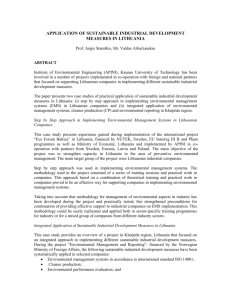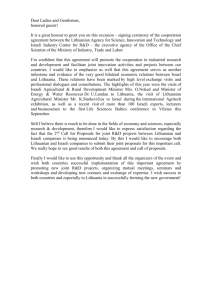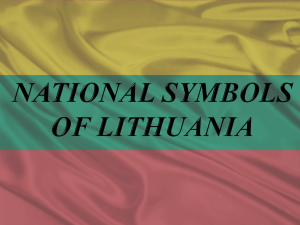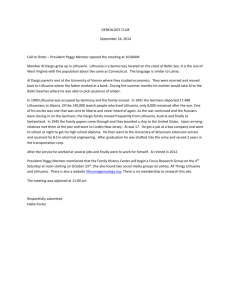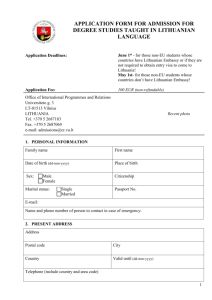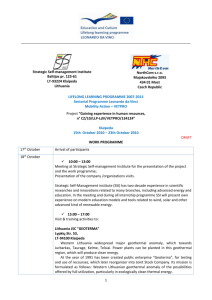The permanent exposition of Kernavė Archaeological Site
advertisement
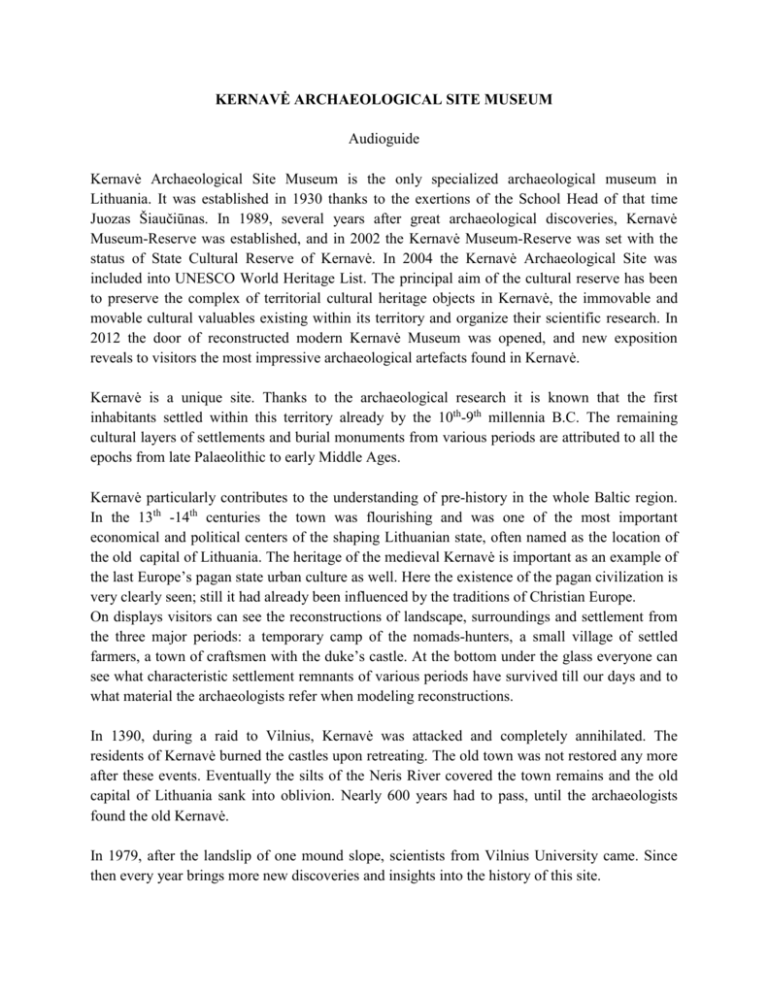
KERNAVĖ ARCHAEOLOGICAL SITE MUSEUM Audioguide Kernavė Archaeological Site Museum is the only specialized archaeological museum in Lithuania. It was established in 1930 thanks to the exertions of the School Head of that time Juozas Šiaučiūnas. In 1989, several years after great archaeological discoveries, Kernavė Museum-Reserve was established, and in 2002 the Kernavė Museum-Reserve was set with the status of State Cultural Reserve of Kernavė. In 2004 the Kernavė Archaeological Site was included into UNESCO World Heritage List. The principal aim of the cultural reserve has been to preserve the complex of territorial cultural heritage objects in Kernavė, the immovable and movable cultural valuables existing within its territory and organize their scientific research. In 2012 the door of reconstructed modern Kernavė Museum was opened, and new exposition reveals to visitors the most impressive archaeological artefacts found in Kernavė. Kernavė is a unique site. Thanks to the archaeological research it is known that the first inhabitants settled within this territory already by the 10th-9th millennia B.C. The remaining cultural layers of settlements and burial monuments from various periods are attributed to all the epochs from late Palaeolithic to early Middle Ages. Kernavė particularly contributes to the understanding of pre-history in the whole Baltic region. In the 13th -14th centuries the town was flourishing and was one of the most important economical and political centers of the shaping Lithuanian state, often named as the location of the old capital of Lithuania. The heritage of the medieval Kernavė is important as an example of the last Europe’s pagan state urban culture as well. Here the existence of the pagan civilization is very clearly seen; still it had already been influenced by the traditions of Christian Europe. On displays visitors can see the reconstructions of landscape, surroundings and settlement from the three major periods: a temporary camp of the nomads-hunters, a small village of settled farmers, a town of craftsmen with the duke’s castle. At the bottom under the glass everyone can see what characteristic settlement remnants of various periods have survived till our days and to what material the archaeologists refer when modeling reconstructions. In 1390, during a raid to Vilnius, Kernavė was attacked and completely annihilated. The residents of Kernavė burned the castles upon retreating. The old town was not restored any more after these events. Eventually the silts of the Neris River covered the town remains and the old capital of Lithuania sank into oblivion. Nearly 600 years had to pass, until the archaeologists found the old Kernavė. In 1979, after the landslip of one mound slope, scientists from Vilnius University came. Since then every year brings more new discoveries and insights into the history of this site. (1) The Arrowhead The findings exhibited in the Pre-History Hall tell about the life in Kernavė during the Stone Age and the Iron Age. First inhabitants appeared on the banks of the Neris River at the end of the old Stone Age, in the 9th millennium B.C. They were reindeer hunters, and following reindeer herds they used to establish temporary camps. They used to make tools and weapons of flint, stone, bone and wood. For nearly 10 thousand years the life quality of our ancestors depended on stone and the tools made of it. The arrowhead of Swidry culture is the earliest artefact from Kernavė testifying that people used to stay in this place in the 10th-9th millennia B.C. after glacier withdrawal. The principal source of living at that time was reindeer hunting and a bow and arrows were the most widely used hunting tools enabling to survive under the severe conditions of the Late Glacial Period. (2) The Axe All the tools of the Stone Age were made with wooden handles, as it facilitated their use and thereby determined their shape. The first axes with handles were made of flint. Some of the most impressive artefacts of the Late Neolith are polished flint axes. For these articles raw flint material of exclusive quality was necessary, it was obtained from distant regions. So supposedly flint axes were both everyday work tools and the symbols of prestige and social status, and were quite often used during religious rituals as well. (3) The Pot – Urn Exceptionally big changes were taking place in our lands during late Neolith period. In the 4th-3rd millennia B.C. migrating Indo-Europeans were flooding to Lithuanian and the surrounding territories, and at the same time agriculture and cattle-breeding appeared and spread; the Baltic tribes and their typical unique culture was forming. Pottery within the territory of Lithuania appeared together with agriculture, i.e. in the Neolith period. In Kernavė the earliest pottery is known from early Bronze Age. It was decorated with strokes and modeled until the first centuries of our era when it was replaced by rusticated pottery. At the same time the pots with polished and even surface were modeled as well. In about the 10th century local inhabitants started using a primitive rotated by hand throwing wheel and with its help they would partly wheel-turn hand modeled pottery. This determined new shapes and ornaments in pottery. Pot fragments are the most frequent finds in archaeological excavations. As pots were modeled strictly following the fashions and rules existing at that time and, as time flew, those fashions were constantly changing, pottery is very important when dating cultural layers or graves. The exhibited pot-urn dates back to the 8th-6th centuries B.C. Cremated bones of a child were buried in it. (4) The Casting Mould Through trade links in the 1st millennium B.C. bronze articles and raw materials reached Lithuania from the territories of Central Europe. Due to the high price of this material stone or bone articles were also used for a long time beside bronze tools or weapons. Although there is no local raw material of non-ferrous metals in the territory of Lithuania and it all had to be imported, the items were produced locally – the found small moulds and other artefacts related with jewellery, i.e. crucibles, scoops, prove this reliably. The spiral disk temple ornaments dating back to the 1st-2nd centuries were mostly spread in Western Lithuania; still this mould found in Kernavė testifies that these items were produced in Eastern Lithuania as well. (5) The Spurs At the turn of our era the inhabitants of Kernavė started extracting iron out of the ores found in local swamps. Iron processing and metal tools unrecognizably changed the everyday life of people, iron jewellery became more accessible for a wider circle of people, better weapons helped to defend themselves from enemies or hunt animals more easily, metal labour tools enabled tilling the soil much more effectively, the life of people was improving, so the number of inhabitants started growing rapidly. The turbulent times in the middle of the first millennium of our era are testified by the considerable increase of weapons and other articles related to military activity, in both the graves of that time and in the cultural layers of the settlements. One of such artefacts is spurs. That is an attribute of a warrior- horseman and provides information on the level and methods of military activity of that time as well. (6) The Shield Boss Besides spears, axes, battle knives, for defense shields were used. In the first millennium of our era shields were produced of wood, so they have not survived till nowadays. One can judge about their use only by their metal parts – shield bosses. A boss of a shield is a cone-shaped or hemispheric iron detail fastened to the middle of the shield. The shield bosses are typical grave goods of the 5th-6th century warrior’s grave found in the cremation graves of Eastern Lithuania burial mounds. (7) The Loom Weight For a long time only furs and leather were used for clothes and only with the appearance of cattle-breeding and agriculture people learned to make fibrous fabrics. Since the Neolith spinning became a craft, inseparable from everyday life. The first yarn was hemp, nettles, wool and flax. Fabrics are a material which deteriorates fast, so the artefacts of them found during archaeological excavations are only exceptional cases. Still, we learn about the fabrics of that time through the discovered tools of spinning and weaving. Small weights of the weaving looms spread in the first centuries of our era, the so-called weights of Djakovo type are often found in the cultural layers of hill-forts. It is thought that they are the weights for vertical weaving looms. (8) Coins from the Roman Empire Trade in pre-historic times was one of the key engines of progress. Only through trade ties new things and ideas used to reach Kernavė. In the 1st-4th centuries of our era the so-called “Amber Road” joined the Balts on Sambia peninsula with the Roman Empire. Various articles were brought from provinces of the Roman Empire to the Baltic lands for exchange. Roman coins used to reach the territory of Lithuania through trade roads. As monetary payment form at that time was not spread yet, coins were used here not according to their purpose. Pierced coins have been found – this proves they used to be worn as jewellery. (9) The Fragment of a Goblet The found fragment of a goblet too testifies the links with distant lands. The provinces of the Roman Empire were centres of production of such goblets, still individual goblets are found throughout wide European region beyond the boundaries of the Roman Empire. Within the territory of Lithuania goblets or other tableware of the Roman period are especially rare artefacts. The trihedral arrows tips exhibited next to the goblet fragments found in Kernavė testify that the warlike steppes nomad tribes were wandering on this land. (10) The Spiral Pin The religion of ancient Balts was pagan – they believed in many gods. We gain quite a lot of information about religion, world view during the research of the burial monuments. The cremation of the deceased is understood as if the separation of soul from the body, its liberation. When burying the deceased, the ancient Lithuanians used to equip them with the most necessary things which, as was believed, they will need in the next world. The first burials found in Kernavė date back to the middle of the 1st millennium B.C. It is the flat cremation burial of the stroked ceramics culture, and so far the only one found both in Eastern Lithuania and in the wider region encompassing part of Belarus as well. The burial was performed in three ways: in stone cairns, small holes and urns. The grave goods are not abundant, not cremated, among them a rare spiral pin has been found. In the 3rd-4th centuries the culture of East Lithuanian burial mounds was formed which existed here till the 12th century. For the dead burial mounds were piled where at that period they were buried not cremated, quite often with multiple grave goods. Most often there was one grave in one burial mound. The burial manner changed again in the 5th-6th centuries. The essential difference is the return of the cremation custom and the grown number of graves in a burial mound. Most often, not one but several people were buried in one burial mound. The role of a warrior grew. That is testified by the main grave goods – weapons. The central part of the burial mound was devoted to a senior in the family, while the other parts of the burial mound were intended for the remaining family members. That might be confirmed by the grave of a girl found on the edge of the burial mound in which there was slightly burnt luxurious jewellery. (11) The Horse Bridle Visitors can see one more development stage of burial tradition in the burial mounds of the 9th10th centuries. The deceased were still buried after cremation but additionally pottery items placed in the graves are found. The widely spread horses graves demonstrate the extraordinary status of a horse in Lithuanian culture. The horses were buried both together with their owners and separately as well by arranging special graves or even by piling a separate burial mound. Just like people the horses were buried decorated – with bridle, decorated with brass or silver, mouthpieces, jingles and similar. (12) The Lithuanian Ingot The Lithuanian state which was established in the 13th century has gone a long road of development; still, its beginning is doubtlessly related with Kernavė. Kernavė is one of the first Lithuanian capitals, the first town – a political-administrative, economical, trades and cultural centre. Here it was not agrarian community that was prevailing in the remaining part of Lithuania; mostly craftsmen and merchants used to live here. In the written sources Kernavė was mentioned for the first time in 1279. According to the archaeological sources it is known that at that time here was a prosperous, developed craftsmen town with a special spiritual culture and intensive trade. The found fragments of scales and weights, various articles and money of that time tell about Kernavė’s trade. Lithuanian Ingots were the earliest Lithuanian money which was in circulation during the 13th-14th centuries. These were silver alloys of half-round stick shape, weighing about 107 grams. At that time this money was of extremely high value. It is considered that 15 sheep could be purchased for one silver alloy. In Kernavė small fragments of Lithuanian Ingots were found as well. They were intended for small payments. After making the chemical analysis of the metal composition it became clear that parts of them are fakes: in the composition of these alloys there was very little silver or it was not found at all. (13) The Lithuanian Coin In the cultural layers of Kernavė medieval town all the types of the earliest Lithuanian coins were found, as well as one very rare coin of Drozdov treasure type which used to be coined in vassal towns of Russia. It is stated that the first coins were coined by Duke Algirdas. These were coins with inscription “печать” and a spearhead on the other side. The small coin types with a portrait and a lion, Vytis and a double cross on a shield are attributed to Jogaila. (14) The Glass Bracelet Kernavė inhabitants were intensively trading with Russian towns. Slate spindles, little crosses, glass bracelets make a big part of goods brought from Russia. In the 10th-11th centuries due to Byzantine influence they already knew how to produce glass in Kiev Russia. In the 13th-14th centuries part of these glass production centers was in the Grand Duchy of Lithuania. Multicoloured glass bracelets and glass beads reached Kernavė as well. In the former Duke’s residence on the Aukuras Hill more than 60 fragments of glass goblets were found, the major part of them was decorated with Eastern polychromatic ornament and some of them were with Arabic symbols. It is thought that these artefacts were brought from Syria and Iran. So in the 13th-14th centuries all glass was imported, therefore it was rare and expensive. In everyday life glass articles were used only in the elite surroundings of the Duke. (15) Venice Merchants’ Seal for Goods Kernavė inhabitants were trading with Western Europe as well. The seal of Venice merchants’ goods demonstrates that fabrics from Venice used to reach Kernavė as well. Leaden seals in the medieval Europe were used for the marking of textile products. In the mound of Aukuras Hill a seal with the image of Saint Mark’s lion was found, it was used by Venice fustian weavers. The best fabrics of this sort were marked by the sign of a lion or a bull, the production of lower quality was marked by the sign of grapes with leaves. (16) The Writing Stylus The stylus found in Aukuras Hill mound is the first writing tool used to write on wax tables or birch bark. It remembers many peaceful or military contracts written by the Duke. Such styluses are a frequent artefact found in the cultural layers of Europe of that time. One end of them is sharp – it is used for writing and another one is wide - used if there was a necessity to rub out the letters inscribed on a wax table. In Kernavė these articles were found in a cultural layer which was formed before 1390. One can judge that these are the earliest writing tools in Lithuania known at present. (17) The Battle Knife The crusades that started in the 13th century shocked the Baltic society and transformed the way of life of the local tribes. The disperse lands of Lithuanians and Aukštaičiai were united into one state of Lithuania and soon Kernavė became the centre of this new entity. According to the written sources Kernavė was attacked thrice: once during the rule of Traidenis, the other two times in the second half of the 14th century. The witnesses of these battles are the arrowheads of crossbows and bows. Although quite a number of battles were fought in Kernavė, few weapons have been found. The weapons were especially valued. People used to gather them after the battles. The rareness of weapons was determined by the changed customs of grave goods placement in Kernavė. The only weapon found in Kernavė cemetery of the 13th-14th centuries is a grave good of a twenty-year-old man – a battle knife. In the 14th century such knives were frequent weapons of townsmen, and from written sources we know that merchants who lived or came to Lithuania had to be armed. Maybe this knife belonged to a man of this social class. (18) The Mountings There is no doubt that weapons and accessories of a horseman-warrior, i.e. spurs and stirrups and various mountings, were attributes of a warriors’ class. The most distinguishing mountings are characterized by a special production technology: they are made of iron and encrusted with silver. These are found mostly in the area of the Baltic tribes – between the territory of Prussians and Eastern Lithuania as well as West Belarus. In recent years such mountings have been considered by the researchers to be an attribute of a Lithuanian warrior. They were placed on belts, shoulder-belts worn by warriors and also on horse bridles. (19) The Jeweller’s Workshop Archaeological research in Kernavė town has shown that the major part of its inhabitants was professional craftsmen. As only a small part of the town has been investigated so far, it is impossible to list all the crafts in which the inhabitants of Kernavė were engaged in the 13th-14th centuries. The most important evidence showing that there was a workplace of a certain craftsman is not the products of that craftsman, but his tools, raw materials, production waste and discarded products. Such jeweller’s workshop was found when the lower town was excavated. It is surprising that the local jewellers knew all the jewellery technologies practiced in Europe at that time: moulding, pressing, embossing, melting and gilding. (20) The Headband In the cemetery of Kernavė of the 13th-14th centuries, 29 headbands, sometimes also called diadems, have been found in women’s graves. A headband is a row of metal plates sewn on a fabric band. The gaps between the plates were embroidered with small glass beads. The plates were most often made of gilded silver and of various shapes. The plates of certain headbands are encrusted with multi-coloured glasses. The townswomen of the Grand Duchy of Lithuania in the 13th-14th centuries loved to decorate themselves with the embellishments of this type; they were especially popular in Yatvingian lands. We can see the motifs typical of both the Christian Europe and the still pagan Baltic world in these plates. Thus this adornment demonstrates that the community in towns was mixed in both ethnic and confession meaning. Religious syncretism was evidently one of its essential traits. (21) The Necklaces The neckrings previously loved in Baltic lands were substituted for various necklaces in medieval times. There were 14 necklaces found in women’s graves in the cemetery of Kernavė of the 13th-14th centuries. Most often this neck adornment was beaded of many different elements – glass beads, brass jingles, spirals, Kauri shells and pendants. Three necklaces had little pendants of the shape of the cross. They testify the influence of the Christian neighbours on the Kernavė community of the 13th -14th centuries. (22) The Ring Unique rings and other jeweller’s articles attributed only to this medieval town have been found in Kernavė as well. Thus these and other adornments typical of only Kernavė indicate that here in the 14th century a unique jewellers school was formed which distinguished itself by unique shapes of articles and subtle manufacturing techniques. (23) The Tools of a Bone Manufacturer One more homestead of a manufacturer was excavated in the lower town. The master who lived there used bone and antler as a material of work. There were tools of a bone manufacturer found in the homestead as well. Employing knives, planes, saws, diamonds and borers the manufacturer used to produce antler and bone articles. (24) The Antler Stamp Along the processing of antler and bone one more craft was developed in the homestead of the bone and antler manufacturer. That was bark ornamentation with an antler stamp. Stamps used for birch bark ornamentation were produced of moose antler. Quite a lot of bone and antler manufacturer skills and special tools were required to carve a sophisticated ornament. Using such stamps a relief ornament was driven into the soaked bark. The whole bark surface was decorated with the same or several stamps. Sometimes a square shaped stamp had only one fourth part of a contrived ornament used to be carved out. The whole sophisticated ornament was pressed by rotating the same stamp at an angle of 90 degrees. Supposedly boxes of various sizes were produced of such ornamented, coloured bark. It is a curious fact that this technique was employed only in medieval Kernavė. (25) The Needle-Case Although no tools of leather master have been found in Kernavė, it is known that for boot sewing or making beautiful needle-cases a person who really knew that craft was necessary. In the cemetery of Kernavė of the 13th-14th centuries, in a woman’s grave, an impressive unique leather needle-case has been found. A small case of fabric was sewn inside and a brass needle was stuck in it. A luxurious floral ornament was created at the top part of the needle-case using a narrow brass strip. The scabbards of some knives found in Kernavė were decorated employing the same technique. Similarly decorated leather footwear is found in other medieval towns as well. (26) The Oak Butt Stock Some artefacts found by the archaeologists, for example, the oak butt stock found in Kernavė, raise more questions than provide answers. Many similar oak sticks with whittled or carved heads were found in Vilnius Lower Castle territory – the cultural layer of the 13th-14th centuries. They were found in Novgorod the Great, Polotsk, Vitebsk, Riga, Grodno, Novogrudok and elsewhere. However, discussions regarding the purpose of these artefacts are going on so far, and there is a debate on what function they have performed – ritual or utilitarian. The fact that nearly all the sticks are made of oak and the tradition of their use disappears immediately after the Baptism of Lithuania is interesting. Therefore part of the researchers call them crooked staff and relate to heathen religion. However, there is a number of other opinions: the sticks could be used for drumming, maybe they were a tool of field game, or were they used simply in cooking? (27) The Signs on the Bottom of a Pot In the medieval times in Kernavė pots were still modeled by hand, but already partly thrown as well. Such articles had thinner walls and were of more regular shapes. Wooden or bone tools slivers were used for decoration. The fact that the pots were modeled by connoisseurs of this craft is testified by signs pressed on the bottoms of the pots. Various pressed in relief symbols have been found on them: a swastika, a cross in a circle and other sophisticated signs. It is thought that they had to be carved on the board of the throwing wheel and were pressed in on the bottoms of the pots. According to the opinion of some researchers these stamps symbolized the “trademark” of the producer – a potter. According to the opinion of others, the stamps on the bottoms of the pot are the sign of the production customer. It is also guessed that the pottery wares marked with various symbols were not used in everyday life and had exclusive sacral purpose. It was believed that these signs used to help to remember what was kept in each pot. (28) The Cylindrical Lock Smithcraft is one of the oldest and most important crafts in Lithuania. The blacksmiths used to make weapons and everyday articles of iron, which was extracted in a hard way. Cylindrical locks were made of iron as well. The cases of cylindrical locks and locking mechanisms, supposedly hidden by the craftsman during the time of the Crusaders attack, were found in Kernavė’s lower town. More parts of locks and keys were found thereabout. One of the locks after fitting a found key operates even till today. Visitors are also invited to look at the reconstruction of a building of Kernavė’s lower town of the 13th-14th centuries. (29) The Grave Goods Two cemeteries of the 13th-14th centuries have been excavated in Kernavė. In one of them the dead used to be buried cremated and then again in water, in another – in the way more acceptable for Christians – inhumated in the ground. In earlier times the dead by a pagan custom used to be cremated in the Eastern Lithuania. This custom had already been partially abandoned before the official Baptism of the country in 1387. Even in the second half of the 13th century a part of the townsmen were buried like Christians – not cremated, with their heads to the West. Still in accordance with the old pagan custom, the dead were buried with abundant grave goods. Women were especially luxuriously seen to another world, they were decorated with luxurious headbands, earrings. The chest area was decorated with necklaces, the hands – with bracelets and rings. Sometimes additional grave goods not related with the worn costume were placed into the graves. These were keys, little spindles and others. Such dual funeral customs demonstrate that the Kernavė community was of syncretic religious creed – Christianity was spreading, but the pagan world outlook was still not forgotten. (30) The Mounting of Swastika Shape In the European Christian context the Baltic pagan jewellery, its shapes and symbols are one of the essential elements illustrating the unique local culture. A cross often used in the décor of Kernavė jewellery articles and especially its rotating version, a swastika, was one of the most popular pagan symbols of the sun beyond the area of the Baltic Tribes as well. Here everyone can see a brass mounting of swastika shape which evidently decorated a leather pouch or a belt. Several silver rings found in Kernavė were also decorated with a swastika sign. This symbol adorns the women headband plates as well. Both jewellery articles and everyday things used to be decorated with swastika – we can see it carved on a wooden oven peel or pressed on the bottom of a clay pot.
